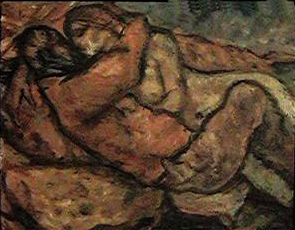Wishbone
Book of Poetry by Priscilla Lee
A fascinating, eclectic mix of tongue-in-check laughter and heartbreak, Wishbone is a reflection on life, at first seen through the eyes of a child forced to grow up before her time, and later, by a woman facing her past. These courageous poems chronicle the life of an Asian American woman at the crossroad of two cultures, transforming her conflicting experiences into self-acceptance, strength, and a wild, free, happiness.
76 pages ( 6 x 8 )
Volume 5 in the California Poetry Series,
presented by Heyday Books and Poetry Flash
co-published with The Roundhouse Press
“Through Priscilla Lee’s Wishbone, we enter a world both magical and harrowing, where the barracudas are melancholy and porcupines are kept as pets, a world in which a firing squad and America are a telegram apart. Seldom are we blessed with a first book as poignant and absorbing as this one is, as street-pure, as wise.”
–Carolyn Forche
“Priscilla Lee’s wonderful Wishbone draws together cultures and varied experiences to form a mature wisdom. A sensuous intelligence of body and mind helps to unite the sacred and profane, and a tension is created in these poems that surprises and pleases. This young poet’s words dance within her well controlled, provocative images–a distilled passion that takes little for granted in this imaginative, observed arena of chance and honed design. Wishbone is bold and tender, shaped out of classical mythologies and everyday life into an earned beauty we can trust.”
–Yusef Komunyakaa
“In Wishbone, Priscilla Lee mixes Kuan Yin and Christmas lights, shark fin dumplings and shots of tequila, the sound of mah jong tiles and slashing punk-rock guitar riffs…Lee patrols the borders of experience with a keen eye and ear for the stories of those who, like Lee herself, perpetually cross back and forth between past and present, fortune and accident, dreams and waking life. It’s our good luck that from her relentless attention she has fashioned these rich, involving poems.”
–Kim Addonizio
Meditation at the Sushi Boat Place
Don’t judge anyone
the way you judge your mother.
Forget ambition. Tangle in someone else’s
sheets at least twice a week.
It doesn’t matter if he’s not there
as long as it makes sense. Sleep until one,
make love until three, order in Szechuan noodles
with chunky peanut butter. Believe you’re immortal
until you die. Never live with your parents
a second time. Never eat anything
bigger than your face. Be free, but not
too free. Don’t sleep with anyone who flosses
his teeth with your hair; no one loves
a plucked ostrich. Repeat to yourself
affirmations don’t work.
The Almighty doesn’t want you
to sound like a leaf-wrapped parrot,
baking in hot ashes. Always mix wasabi
with ice cream made of green tea.
Advice from a Former Lover, an Artist
You and I share a hunger for this perverse world.
We bear the mark of Cain, perpetually creating
to justify our ugliness. Since you married
my friend, we haven’t talked. Can I share some
advice with you? My wife and I also tried to be
like my parents: to dig, plant, grow, and eat
from the same soil together. Well, Satan be praised,
you don’t have to trail three steps behind
your husband, and we don’t have to preserve
turnips in brine. The force of creation is not passive.
An artist chisels out form ruthlessly with full
intent. Show your obsessions like a marquee
on opening night. Pick the fruits ripe for you
and feast on the body. Ask him what he’d like
to sample first–red-fleshed blood oranges,
the translucent pulp pomegranates…
When the girl-next-door waves her supple
scent in front of his nose and your tongue
dances like a flame, he may want a taste.
Sometimes, I look at my wife and say–
do you want to seduce another woman
while I watch? That’s how I talk to my honey.
Other times, I tell friends my wife wants two men.
I blame it on her, but you know I love the act
of giving shape to desire, the inexplicable light
that lets us look into the secrets of others.
How to Stuff an Eggplant
For once, forget Bongo’s Burger Joint
& thank El Nino for the pulsing hillsides.
Go to the farmer’s market & choose
a glossy eggplant, just-harvested,
that shimmers back at you.
At home, rub its purple skin with dark oil
carried up from a cool cellar.
Broil the eggplant inches from the heat.
Carefully scoop the spongy white flesh,
leaving walls thick enough to hold.
Fill the hollow with walnuts, tangy feta,
& pomegranate seeds. Pack a basket.
Walk slowly along a trail winding
through wildflowers, a riot of color
down to the beach. Don’t hurry.
Scatter the fat sparrows as you shake out
your picnic cloth stained with grass
from last summer. Place the eggplant,
warm & full, in the curve
of your lover’s palm. Watch him
savor the soft succulent meat.
Dig your toes into the sand.
Let the mingled juices drip
onto the blanket while he nibbles.
Aggression Cookies
(A post-modern Asian American performance poem)
2 cups unsalted butter, room temperature
1 cup sugar
2 cups light brown sugar
4 eggs
1 tbsp vanilla (this brand with a long name, sold at any yuppy kitchenware
boutique)
4 1/2 cups flour
2 tsps baking soda
With thick Chinese meat cleaver, hack to pieces:
24 oz semi-sweet chocolate bar
12 oz white chocolate bar
14 oz macadamia nuts
NOTE
You may substitute chocolate and white chocolate chips for the bars
if you are not feeling particularly angst-ridden.
Preheat oven to 375 degrees.
In a large bowl, thrash butter and sugars until uniform.
Beat in eggs and vanilla.
Add flour and baking soda; whip until smooth.
Toss in chocolate chunks and nuts.
To avoid the "chocolate chip cookie manhole cover" look,
refrigerate the cookie dough for a couple of hours before baking.
Throw batter by tablespoons full onto an ungreased
baking sheet–aim so that the cookies land 2 inches apart.
Bake until golden, about 10-12 minutes.
Using a spatula, pry the cookies loose from the baking sheet,
and allow them to vent on wire racks.
Makes about 4 dozen cookies.
Isolde: A Way Out
When my sadness ends
I’ll reach outside to you
my heart
no longer clenched
like teeth to haul
the heavy blackness near
or cut wide
to swallow distances–
dark hole
drawing around me
tight as a crinkled mouth.
When my sadness ends
my mind will flower–
bloom blood
into a heart
no longer like
a fetus
coiled in
a knot of veins
but a core of
splitting thistles
my flush
of red pine extending
into the edges of a room.
Related Links:
Poetry Magazine, Dec 2002
Poetry Magazine, Nov 2002
Moon Cake, by Priscilla Lee
At the Wonton Monkee
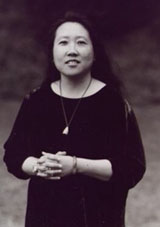
Priscilla Lee
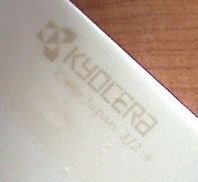 Because it’s ceramic, I definitely have to be more careful of breaking or chipping it. Unlike metal it does not bend. The blade is made of zirconium oxide, which is second in hardness only to diamonds. It is especially excellent for cutting fruit and vegetables that would otherwise brown if sliced with a metal knife.
Because it’s ceramic, I definitely have to be more careful of breaking or chipping it. Unlike metal it does not bend. The blade is made of zirconium oxide, which is second in hardness only to diamonds. It is especially excellent for cutting fruit and vegetables that would otherwise brown if sliced with a metal knife.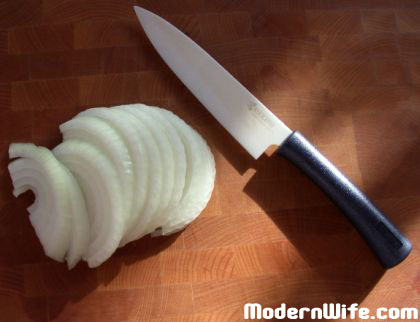

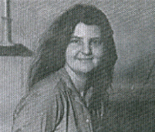 Cornelia was born in Manhattan on the 18th of February, 1928. She attended Yale University School of Art in New Haven, CT, taking courses in painting and sculpture. Aside from her oil paintings, Cornelia also created marionettes. She wrote and illustrated “Seventeen Poems of Fairyland” in 1952. Cornelia Schwarz Stefatos was a Democratic Party Chairwoman for 15 years. In 1973, Cornelia retreated to a Victorian Mansion in New Brighton, Staten Island, where she lived with her old dog Shempie and fellow artists. She died on the 16th of January, 1998.
Cornelia was born in Manhattan on the 18th of February, 1928. She attended Yale University School of Art in New Haven, CT, taking courses in painting and sculpture. Aside from her oil paintings, Cornelia also created marionettes. She wrote and illustrated “Seventeen Poems of Fairyland” in 1952. Cornelia Schwarz Stefatos was a Democratic Party Chairwoman for 15 years. In 1973, Cornelia retreated to a Victorian Mansion in New Brighton, Staten Island, where she lived with her old dog Shempie and fellow artists. She died on the 16th of January, 1998.



